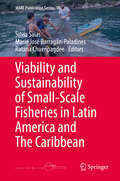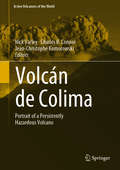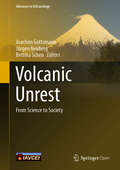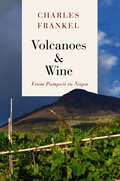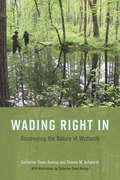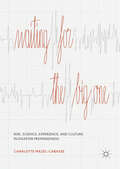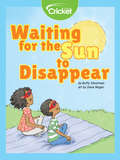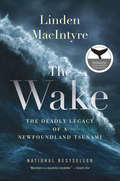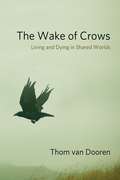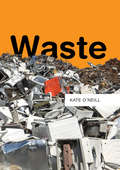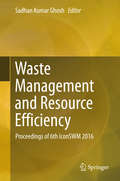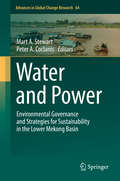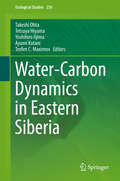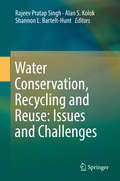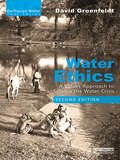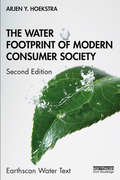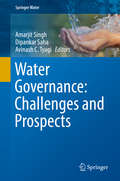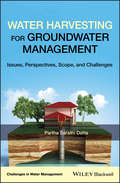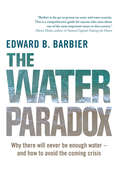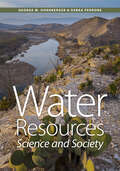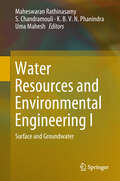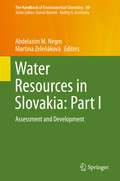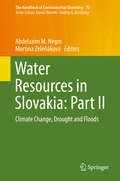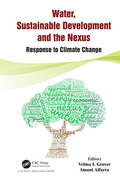- Table View
- List View
Viability and Sustainability of Small-Scale Fisheries in Latin America and The Caribbean (MARE Publication Series #19)
by Silvia Salas María José Barragán-Paladines Ratana ChuenpagdeeOne of the main goals in fisheries governance is to promote viability and sustainability in small-scale fishing communities. This is not an easy task given external and internal pressure, including environmental change and competition with other economic sectors searching for development in the coastal region. A comprehensive understanding of small-scale fisheries in their own context, and from a regional perspective, is an important step in supporting the implementation of the Voluntary Guidelines on Securing Sustainable Small-Scale Fisheries (SSF Guidelines). This book contributes to the global effort by offering knowledge, insights and lessons about small-scale fisheries in Latin America and the Caribbean. The 20 case studies included in the book make explicit the various dimensions that are intrinsic to small-scale fisheries in the region, and identify conditions and situations that affect the wellbeing of fishing communities. The book offers insights regarding the challenges faced by small-scale fisheries in the region, and, aligning with the objectives of the SSF Guidelines, provides lessons and experiences about how to make small-scale fishing communities viable while maintaining sustainable fisheries. This important book illustrates the complexity, diversity, and dynamics of small-scale fisheries in the Latin American and Caribbean region and presents experiences, tools, and approaches to lead towards sustainable and viable fisheries. The reader will gain a new understanding on the range of actions, approaches, and information needed for their successful management. John F. Caddy, International Fisheries ExpertThis book, prepared by the Too Big To Ignore partnership, constitutes a very valuable resource for policy makers, fisheries scientists, non-governmental organizations, civil society organizations, and fishing communities interested in putting in place sound management strategies, research, and actions to contribute to the sustainability of small-scale fisheries and food security in Latin America and the Caribbean region. Juan Carlos Seijo, Professor of Fisheries Bioeconomics at Marist University of Merida
Vibration Analysis of Functionally Graded Piezoelectric Actuators (SpringerBriefs in Applied Sciences and Technology)
by Pankaj SharmaThis book presents a detailed study on the vibration analysis of functionally graded piezoelectric actuators excited under the shear effect. Two types of actuator geometries viz. beam and annular plate are considered, where the material properties are assumed to have a continuous variation in accordance with a power law distribution. The generalized differential quadrature method is used to obtain the solutions, and is compared to exact analytical results. The methodology reported and the numerical results presented will be useful for the design of devices utilizing functionally graded piezoelectric actuators under the influence of shear.
Volcán de Colima: Portrait of a Persistently Hazardous Volcano (Active Volcanoes of the World)
by Nick Varley Charles B. Connor Jean-Christophe KomorowskiThis book represents a comprehensive coverage of the current state of knowledge of Volcán de Colima: its history, its eruptive mechanism, the generation and interpretation of monitoring data, and the risk presented to the local population. The volume pulls together the results of the most important studies of recent years from many areas of volcanology: the geology of its eruptive products; geophysical and geochemical studies of the signals measured that relate to the generation and movement of magma; experimental analysis of its internal processes and the social complexities relating to the risk imposed by future eruptions. Volcán de Colima is an important volcano: it has frequent large Plinian or sub-Plinian eruptions; its activity frequently switches between various regimes, which provides the opportunity to study these transitions from their cause to their impact; and it is a volcano which poses a significant threat to a large population.
Volcanic Unrest: From Science To Society (Advances In Volcanology Ser.)
by Joachim Gottsmann Jürgen Neuberg Bettina ScheuThis open access book summarizes the findings of the VUELCO project, a multi-disciplinary and cross-boundary research funded by the European Commission's 7th framework program. It comprises four broad topics:1. The global significance of volcanic unrest2. Geophysical and geochemical fingerprints of unrest and precursory activity3. Magma dynamics leading to unrest phenomena4. Bridging the gap between science and decision-makingVolcanic unrest is a complex multi-hazard phenomenon. The fact that unrest may, or may not lead to an imminent eruption contributes significant uncertainty to short-term volcanic hazard and risk assessment. Although it is reasonable to assume that all eruptions are associated with precursory activity of some sort, the understanding of the causative links between subsurface processes, resulting unrest signals and imminent eruption is incomplete. When a volcano evolves from dormancy into a phase of unrest, important scientific, political and social questions need to be addressed. This book is aimed at graduate students, researchers of volcanic phenomena, professionals in volcanic hazard and risk assessment, observatory personnel, as well as emergency managers who wish to learn about the complex nature of volcanic unrest and how to utilize new findings to deal with unrest phenomena at scientific and emergency managing levels. This book is open access under a CC BY license.
Volcanoes and Wine: From Pompeii to Napa
by Charles FrankelThere’s a reason we pay top dollar for champagne and that bottles of wine from prestige vineyards cost as much as a car: a place’s distinct geographical attributes, known as terroir to wine buffs, determine the unique profile of a wine—and some rarer locales produce wines that are particularly coveted. In Volcanoes and Wine, geologist Charles Frankel introduces us to the volcanoes that are among the most dramatic and ideal landscapes for wine making. Traveling across regions wellknown to wine lovers like Sicily, Oregon, and California, as well as the less familiar places, such as the Canary Islands, Frankel gives an in-depth account of famous volcanoes and the wines that spring from their idiosyncratic soils. From Santorini’s vineyards of rocky pumice dating back to a four-thousand-year-old eruption to grapes growing in craters dug in the earth of the Canary Islands, from Vesuvius’s famous Lacryma Christi to the ambitious new generation of wine growers reviving the traditional grapes of Mount Etna, Frankel takes us across the stunning and dangerous world of volcanic wines. He details each volcano’s most famous eruptions, the grapes that grow in its soils, and the people who make their homes on its slopes, adapting to an ever-menacing landscape. In addition to introducing the history and geology of these volcanoes, Frankel's book serves as a travel guide, offering a host of tips ranging from prominent vineyards to visit to scenic hikes in each location. This illuminating guide will be indispensable for wine lovers looking to learn more about volcanic terroirs, as well as anyone curious about how cultural heritage can survive and thrive in the shadow of geological danger.
Wading Right In: Discovering the Nature of Wetlands
by Catherine Owen Koning Sharon M. AshworthWhere can you find mosses that change landscapes, salamanders with algae in their skin, and carnivorous plants containing whole ecosystems in their furled leaves? Where can you find swamp-trompers, wildlife watchers, marsh managers, and mud-mad scientists? In wetlands, those complex habitats that play such vital ecological roles. In Wading Right In, Catherine Owen Koning and Sharon M. Ashworth take us on a journey into wetlands through stories from the people who wade in the muck. Traveling alongside scientists, explorers, and kids with waders and nets, the authors uncover the inextricably entwined relationships between the water flows, natural chemistry, soils, flora, and fauna of our floodplain forests, fens, bogs, marshes, and mires. Tales of mighty efforts to protect rare orchids, restore salt marshes, and preserve sedge meadows become portals through which we visit major wetland types and discover their secrets, while also learning critical ecological lessons. The United States still loses wetlands at a rate of 13,800 acres per year. Such loss diminishes the water quality of our rivers and lakes, depletes our capacity for flood control, reduces our ability to mitigate climate change, and further impoverishes our biodiversity. Koning and Ashworth’s stories captivate the imagination and inspire the emotional and intellectual connections we need to commit to protecting these magical and mysterious places.
Waiting for the Big One: Risk, Science, Experience, and Culture in Disaster Preparedness
by Charlotte Mazel-CabasseThis book helps understand how the future Big One (a large-scale and often-predicted earthquake) is understood, defined, and mitigated by experts, scientists, and residents in the San Francisco Bay Area. Following the idea that earthquake risk is multiple and hard to grasp, the book explores the earthquake’s “mode of existence,” guiding the reader through different epistemic moments of the earthquake-risk definition. Through in-depth interviews, the book provides a rarely seen anthropology of risk from the perspective of experts, scientists, and concerned residents for whom the possibility of partial or complete destruction of their living environment is a constant companion of their everyday lives. It argues that the characterization of the threats and the measures taken to limit its impacts constitute an integrated part of both their residential experiences and their professional practices.
Waiting for the Sun to Disappear
by Buffy SilvermanJeff and his cousin Liz are waiting to see the solar eclipse! Together, they learn about why eclipses happen and why seeing one is special. Do you know why eclipses happen? Learn how the moon and sun interact with Earth in order to create this solar spectacular!
The Wake: The Deadly Legacy of a Newfoundland Tsunami
by Linden MacIntyreIn the vein of Erik Larson’s Isaac’s Storm and Dead Wake comes an incredible true story of destruction and survival in Newfoundland by one of Canada’s best-known writersOn November 18, 1929, a tsunami struck Newfoundland’s Burin Peninsula. Giant waves, up to three storeys high, hit the coast at a hundred kilometres per hour, flooding dozens of communities and washing entire houses out to sea. The most destructive earthquake-related event in Newfoundland’s history, the disaster killed twenty-eight people and left hundreds more homeless or destitute. It took days for the outside world to find out about the death and damage caused by the tsunami, which forever changed the lives of the inhabitants of the fishing outports along the Burin Peninsula.Scotiabank Giller Prize–winning writer Linden MacIntyre was born near St. Lawrence, Newfoundland, one of the villages virtually destroyed by the tsunami. By the time of his birth, the cod-fishing industry lay in ruins and the village had become a mining town. MacIntyre’s father, lured from Cape Breton to Newfoundland by a steady salary, worked in St. Lawrence in an underground mine that was later found to be radioactive. Hundreds of miners would die; hundreds more would struggle through shortened lives profoundly compromised by lung diseases ranging from silicosis and bronchitis to cancer. As MacIntyre says, though the tsunami killed twenty-eight people in 1929, it would claim hundreds if not thousands more lives in the decades to follow. And by the time the village returned to its roots and set up as a cod fishery once again, the stocks in the Grand Banks had plummeted and St. Lawrence found itself once again on the brink of disaster.Written in MacIntyre’s trademark style, The Wake is a major new work by one of this country’s top writers.
The Wake of Crows: Living and Dying in Shared Worlds (Critical Perspectives on Animals: Theory, Culture, Science, and Law)
by Thom van DoorenCrows can be found almost everywhere that people are, from tropical islands to deserts and arctic forests, from densely populated cities to suburbs and farms. Across these diverse landscapes, many species of crow are doing well: their intelligent and adaptive ways of life have allowed them to thrive amid human-driven transformations. Indeed, crows are frequently disliked for their success, seen as pests, threats, and scavengers on the detritus of human life. But among the vast variety of crows, there are also critically endangered species that are barely hanging on to existence, some of them the subjects of passionate conservation efforts.The Wake of Crows is an exploration of the entangled lives of humans and crows. Focusing on five key sites, Thom van Dooren asks how we might live well with crows in a changing world. He explores contemporary possibilities for shared life emerging in the context of ongoing processes of globalization, colonization, urbanization, and climate change. Moving among these diverse contexts, this book tells stories of extermination and extinction alongside fragile efforts to better understand and make room for other species. Grounded in the careful work of paying attention to particular crows and their people, The Wake of Crows is an effort to imagine and put into practice a multispecies ethics. In so doing, van Dooren explores some of the possibilities that still exist for living and dying well on this damaged planet.
Waste: Building A New Theory Of Environmental Regulation (American And Comparative Environmental Policy Ser.)
by Kate O'NeillWaste is one of the planet’s last great resource frontiers. From furniture made from up-cycled wood to gold extracted from computer circuit boards, artisans and multinational corporations alike are finding ways to profit from waste while diverting materials from overcrowded landfills. Yet beyond these benefits, this “new” resource still poses serious risks to human health and the environment. In this unique book, Kate O’Neill traces the emergence of the global political economy of wastes over the past two decades. She explains how the emergence of waste governance initiatives and mechanisms can help us deal with both the risks and the opportunities associated with the hundreds of millions – possibly billions – of tons of waste we generate each year. Drawing on a range of fascinating case studies to develop her arguments, including China’s role as the primary recipient of recyclable plastics and scrap paper from the Western world, “Zero-Waste” initiatives, the emergence of transnational waste-pickers’ alliances, and alternatives for managing growing volumes of electronic and food wastes, O’Neill shows how waste can be a risk, a resource, and even a livelihood, with implications for governance at local, national, and global levels.
Waste Management and Resource Efficiency: Proceedings of 6th IconSWM 2016
by Sadhan Kumar GhoshThe book contains high-quality research papers presented at Sixth International Conference on Solid Waste Management held at Jadavpur University, Kolkata India during November 23-26, 2016. The Conference, IconSWM 2016, is organized by Centre for Quality Management System, Jadavpur University in association with premier institutes and societies of India. The researchers from more than 30 countries presented their work in Solid Waste Management. The book is divided into two volumes and deliberates on various issues related to innovation and implementation in sustainable waste management, segregation, collection, transportation of waste, treatment technology, policy and strategies, energy recovery, life cycle analysis, climate change, research and business opportunities.
Water and Power: Environmental Governance And Strategies For Sustainability In The Lower Mekong Basin (Advances In Global Change Research #64)
by Peter A. Coclanis Mart A. StewartThis book brings together a talented international group of scholars, policy practitioners, and NGO professionals that explores a range of issues relating to environmental, developmental, and governing challenges on the Mekong, one of the world’s greatest rivers and, alas, one of the most endangered. <p><p> The book is divided into three sections devoted in turn to historical perspectives on the Lower Mekong Basin. Issues relate to livelihood strategies, environmental threats, and adaptation strategies; and various aspects of river governance, with individual authors treating questions of governance at different levels of refraction and in different registers. The result is a fresh and innovative collection of essays, which, taken together, provide much-needed new perspectives on some of the most important and seemingly intractable environmental and development issues in contemporary Asia.
Water-Carbon Dynamics in Eastern Siberia (Ecological Studies #236)
by Takeshi Ohta Tetsuya Hiyama Yoshihiro Iijima Ayumi Kotani Trofim C. MaximovThis book discusses the water and carbon cycle system in the permafrost region of eastern Siberia, Providing vitalin sights into how climate change has affected the permafrost environment in recent decades. It analyzes the relationships between precipitation and evapotranspiration, gross primary production and runoff in the permafrost regions, which differ from those intropical and temperate forests. Eastern Siberia is located in the easternmost part of the Eurasian continent, and the land surface with underlying permafrost has developed over a period of seventy thousand years. The permafrost ecosystem has specific hydrological and meteorological characteristics in terms of the water and carbon dynamics, and the current global warming and resulting changes in the permafrost environment are serious issues in the high-latitude regions. The book is a valuable resource for students, researchers and professionals interested in forest meteorology and hydrology, forest ecology, and boreal vegetation, as well as the impact of climate change and water-carbon cycles in permafrost and non-permafrost regions.
Water Conservation, Recycling and Reuse: Issues and Challenges
by Rajeev Pratap Singh Alan S. Kolok Shannon L. Bartelt-HuntWater - a basic element of life, livelihood, food security and sustainable development - holds the key to global sustainability. The global water demand has been increased 3-fold in the past five decades and only 0.4% of the total world’s fresh water resources is available and accessible for use. The United Nations projected that half of all countries will face water scarcity by 2025 and more than one-third of the world’s population could be affected by water stress by 2050. The water problem is rapidly intensifying in the Asian region, and around 700 million people do not have access to safe drinking water. Similarly, according to the Intergovernmental Panel on Climate Change (IPCC) report, by 2050, more than one billion people in Asia alone are projected to experience negative impacts on water resources as a result of climate change. Climate change is also putting extra pressure on and adversely affecting the global water cycle, leading to irregular precipitation, more floods and droughts and creating an imbalance between water supply and demand. The availability of safe water is a major global concern due to the rapidly increasing population, urbanization, unsustainable consumption patterns, and rapid shifts in land use. It is believed that reduced access to freshwater will have cascading consequences that will pose threat to global food security, livelihood security, and cause large scale migration and economic and geopolitical tensions. As such, strategies for water conservation, wastewater reuse and recycling should be adopted in order to lessen the gap between supply and demand for water for different activities. This book provides readers with a better understanding of the water security challenges, and presents innovations to address these challenges, strengthen the science-policy interface, and develop institutional and human capacities for water security and sustainability.
Water Ethics: A Values Approach to Solving the Water Crisis (Earthscan Water Text)
by David GroenfeldtFully revised and updated, this second edition of Water Ethics continues to consolidate water ethics as a key dimension of water-related decisions. The book introduces the idea that ethics are an intrinsic dimension of any water policy, program, or practice, and that understanding what ethics are being acted out in water policies is fundamental to an understanding of water resource management. Alongside updated references and the introduction of discussion questions and recommended further reading, this new edition discusses in depth three significant developments since the publication of the first edition in 2013. The first is the growing awareness of the climate crisis as an existential threat, and associated concern about adaptive strategies for sustainable water management and ways of using water management for climate mitigation (e.g., practically through agricultural soil management and conceptually through ethics awareness). Second, there has been increased clarity among the religious community, Indigenous leaders, and progressive academics that ethics needs to become an arena for application and action (e.g., the Vatican encyclical Laudato Si, protests at Standing Rock and Flint, Michigan, in the US, and climate demonstrations worldwide). Thirdly, there have been new normative water standards ranging from "water stewardship" (industry initiative), water charters (Berlin) and the on-going initiative to develop a global water ethics charter. Drawing on case studies from countries including Australia, India, the Philippines, South Africa, and the United States, this textbook is essential reading for students of environmental ethics and water governance and management.
The Water Footprint of Modern Consumer Society (Earthscan Water Text)
by Arjen Y. HoekstraUsing the water footprint concept, this impactful book aids our understanding of how we can reduce water consumption and pollution to sustainable levels. Since the publication of the first edition, the question of how to reduce our water footprint has become even more urgent. Freshwater scarcity is increasingly perceived as a global systemic risk and overconsumption of water is widespread. The water footprint, a concept founded by the author, is an indicator of direct and indirect freshwater use by a consumer or producer that can be used to analyze water usage along supply chains and assess the sustainability, efficiency and fairness of our water use. This new edition is fully revised and updated to reflect continued developments in this rapidly growing field of knowledge. New chapters are added covering the history of the water footprint concept; the environmental footprint of the human species versus planetary boundaries; and the human right to water as a foundation to equitable sharing. All other chapters are fully revised with new findings, applications and references, including major new research on energy, vegetarian diets and intelligent water allocation over competing demands. The Water Footprint of Modern Consumer Society is a key textbook for students of interdisciplinary water studies and those taking other related courses within the environmental sciences. It will also be of interest to those working in the governmental sector, environmental and consumer organizations, the business sector and UN institutions, where there is growing interest in the water footprint concept.
Water Governance: Challenges and Prospects (Springer Water)
by Amarjit Singh Dipankar Saha Avinash C. TyagiThe book is the first of its kind to deal with almost the entire swath of water resources assessment, development and sustainable management. The idea of the book crystallized during the long journey of the Editors on various facets of water issues in India and abroad during their extended association, at all levels with the Ministry of Water Resources, River Development and Ganga Rejuvenation, as well as International Organizations dealing with water. Currently water-stressed, India is likely to become water scarce in not too distant a future. The global freshwater supply and its sustainable use for human consumption, and conservation of the ecosystem have never come under such a rigorous scrutiny before. The unplanned and reckless exploitation of this precious resource have led to a crisis situation, compounded by a real threat of climate change. This book is, therefore, timely and of particular relevance not only to India but the entire world. The book contains 20 chapters, beside the lead article by the Editors. The chapters are contributed by the eminent professionals, researchers, academicians and civil society representatives having an in-depth understanding of the issues. The contents of the chapters have been chosen to represent all aspects of water. The assessment of water resources using satellite data and in-depth analyses of groundwater sector like, the Aquifer Mapping Programme initiated by Government of India, application of gravity satellite data to assess the resource build up, artificial recharge of aquifers and its contamination, are dealt with by eminent experts. The articles on sustainable management of water through good governance by community participation and involvement of civil society are placed. Flood management both through a basin level approach as well as by building resilience in vulnerable areas is discussed. Other critical issues like water bodies management, constitutional provisions, water governance and financial issues, hydro-power and need of research and development in this sector are also dealt with aptly. In view of emerging crisis and complexities in this sector the future pathways and the paradigm shift that is required in administrative and policy level is also discussed.
Water Harvesting for Groundwater Management: Issues, Perspectives, Scope, and Challenges (Challenges in Water Management Series)
by Partha Sarathi DattaOutlines the concept and principles of water harvesting for groundwater management for an international audience, and looks at the positives and negatives surrounding water harvesting technologies This book is the first to fully outline the concept and principles of water harvesting for groundwater management for a global audience. It offers guidance to academics, students and researchers on effective water harvesting approaches for groundwater recharge, and educates them on the risks associated with managed aquifer recharge, as well as the causes of success or failure of particular management strategies, and demand management strategies and tools. The book is helpful to water managers, administrators, and professionals, to make decisions to allocate resources; developing innovative cost-effective measures and approaches to achieve demand-supply balance. The book provides readers with an overview of the historical evolution of water harvesting for groundwater recharge. It looks at the benefits and gaps in knowledge, their implementation and funding strategies, and public participation. It also assesses the strengths, weaknesses, opportunities, and threats (SWOT) of water harvesting technologies. Water Harvesting for Groundwater Management: Issues, Perspectives, Scope and Challenges offers chapters covering: issues on water harvesting and water security; mega-trends that impact water security; groundwater occurrence, availability, and recharge-ability; phases of water harvesting systems; SWOT analysis of water harvesting systems; case studies and short examples of implementing water harvesting; scope of water harvesting for GWM strategies; guidelines to make water harvesting helpful and meaningful for GWM; and more. Summarizes the theories and applications of water harvesting for groundwater management for a world audience Offers guidance on effective water harvesting approaches for groundwater recharge, managed aquifer recharge, and successful water management strategies Evaluates the strengths, weaknesses, opportunities and threats (SWOT) of water harvesting technologies Part of the Challenges in Water Management series Water Harvesting for Groundwater Management: Issues, Perspectives, Scope and Challenges is an excellent resource for water management professionals working with water harvesting technologies, and will be of great interest to water managers, administrators, professionals, academics and researchers working in water management.
The Water Paradox: Overcoming the Global Crisis in Water Management
by Ed BarbierA radical new approach to tackling the growing threat of water scarcity Water is essential to life, yet humankind’s relationship with water is complex. For millennia, we have perceived it as abundant and easily accessible. But water shortages are fast becoming a persistent reality for all nations, rich and poor. With demand outstripping supply, a global water crisis is imminent. In this trenchant critique of current water policies and practices, Edward Barbier argues that our water crisis is as much a failure of water management as it is a result of scarcity. Outdated governance structures and institutions, combined with continual underpricing, have perpetuated the overuse and undervaluation of water and disincentivized much-needed technological innovation. As a result “water grabbing” is on the rise, and cooperation to resolve these disputes is increasingly fraught. Barbier draws on evidence from countries across the globe to show the scale of the problem, and outlines the policy and management solutions needed to avert this crisis.
Water Resources: Science and Society
by George M. Hornberger Debra PerroneA scientifically rigorous text grounded in socioeconomic reality that examines both physical hydrology and contemporary water usage issues.The fair allocation and wise use of fresh water presents significant challenges across the world. To avoid unresolvable crises in the future, judiciously managing water resources in the twenty-first century is fundamentally important. Integrating the underlying science of hydrology with real-world usage scenarios, Water Resources offers a nuanced, modern treatment of contemporary water resource management issues.In this ground-breaking new text, renowned environmental scientist and educator George M. Hornberger and award-winning environmental engineer Debra Perrone examine the role of water resources in natural, social, and human-built systems, helping students understand and evaluate the complex tradeoffs required to achieve sustainable water management. Providing a much-needed educational tool that looks at freshwater resources within the context of the crucial water-energy-food nexus, the text • includes a primer on the elements of physical hydrology necessary to understand resource availability; • covers rivers, lakes, groundwater, and soil water;• relates water to agriculture, energy, urbanization, and the environment;• highlights connections between water quantity and quality; • explains the economic and legal constraints around water resources; • considers the impacts of climate change and population growth; and• proposes paths forward for the sustainable use of water.Teaching basic methods used to make informed water management decisions, the book includes illustrative quantitative calculations, qualitative think-pieces, and case studies. An appendix provides a review of units, dimensions, and conversions useful for addressing each chapter's example problems. Online answer keys are also available.Positioned to become the foremost text on water resource issues, this companion to Hornberger's widely regarded Elements of Physical Hydrology reveals the enormity of the water crisis facing the planet while offering realistic hope.
Water Resources and Environmental Engineering I: Surface And Groundwater
by K.B.V.N. Phanindra Uma Mahesh S. Chandramouli Maheswaran RathinasamyThe book is a compilation of the papers presented in the International Conference on Emerging Trends in Water Resources and Environmental Engineering (ETWREE 2017). The high quality papers are written by research scholars and academicians of prestigious institutes across India. The book discusses the challenges of water management due to misuse or abuse of water resources and the ever mounting challenges on use, reuse and conservation of water. It also discusses issues of water resources such as water quantity, quality, management and planning for the benefits of water resource scientists, faculties, policy makers, stake holders working in the water resources planning and management. The research content discussed in the book will be helpful for engineers to solve practical day to day problems related to water and environmental engineering.
Water Resources in Slovakia: Assessment And Development (The Handbook of Environmental Chemistry #69)
by Abdelazim M. Negm Martina ZeleňákováThis volume presents up-to-date information on the status and assessment of water resources in Slovakia and methods for their development. The major themes include key facts about Slovakian water resources, their assessment and development; water supply and demand; irrigation water; groundwater; water and sediment quality with a focus on mining water; wastewater management in Slovakia; and rainwater management. The book closes with general conclusions and recommendations for future research. It is a valuable resource for graduate students and researchers as well as for decision makers involved in sustainable development.
Water Resources in Slovakia: Climate Change, Drought And Floods (The Handbook of Environmental Chemistry #70)
by Abdelazim M. Negm Martina ZeleňákováThis book offers up-to-date information on the impact of climate change on water resources in Slovakia, the occurrence of drought and floods, hazards and protection methods. The topics covered include hydrological extremes, such as droughts and flood, in Slovakia; risk assessment and protection; sustainable management; and water management in buildings. The closing chapter provides general conclusions and recommendations for future research. It appeals to graduate students and researchers as well as to decision makers involved in planning future water resources in Slovakia.
Water, Sustainable Development and the Nexus: Response to Climate Change (Water)
by Velma I. Grover Amani AlfarraWater is intricately linked with food security, energy security, and sustainable development. As the world is moving towards sustainable development goals, it is critical to recognize the role of water in attaining these goals. The Water-Energy-Food Nexus draws attention to the complex and interrelated nature of global resource systems and forces us to think about how a decision in one sector impacts other interlinked sectors as well. This book looks at the three dimensions of sustainable development-environment, economics and society-and how water is linked with them and explores the nexus approach as a framework to look at the issues and identify solutions.
